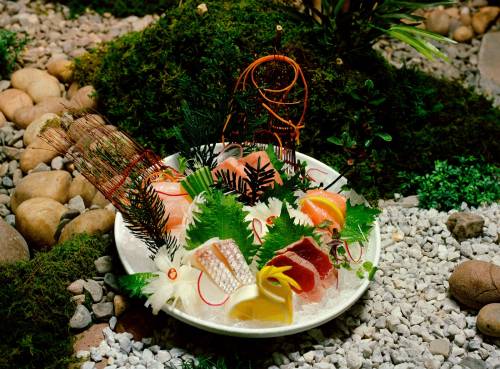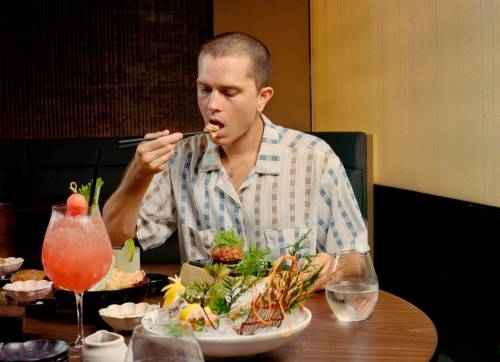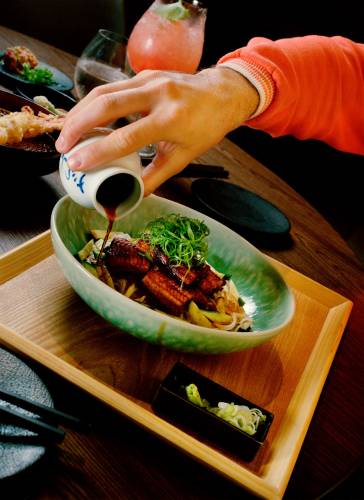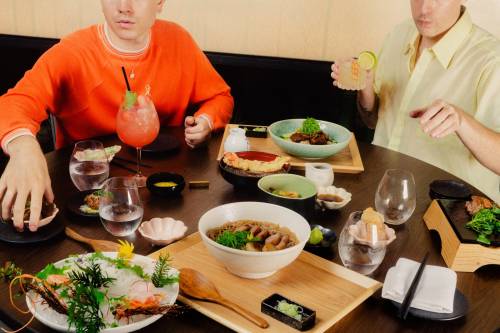My first experience with soba, the thin Japanese noodle made from buckwheat, was at Honmura An, a temple of Zen elegance in SoHo that, starting in 1991, made its noodles by hand, on the premises, for sixteen years. It was also the first time I had sea urchin, and Honmura An’s soba with uni remains one of the formative (read: rapturous) meals of my life. After that restaurant’s chef and owner, Koichi Kobari, closed shop, in 2007, and left for Tokyo (where he took over his father’s soba restaurant, Honmura-an), it wasn’t until Cocoron came along, a few years later, that I fell, again, for soba.

The extremely fresh sashimi plate at Sarashina Horii can include toro, seared tuna, salmon, and sea bream.
Far from Honmura An’s hushed reverence, the atmosphere at Cocoron, a tidy hole in the wall on Nolita’s Kenmare Street (one of a few locations over the years), starts with its kooky, exuberant menu. Full of pictures, charts, and quotes from an unnamed source—“Get recovery and energy if you’re not feeling well”; “Toppings will always support you!”—it dotes on how healthy and delightful its many dishes, such as the ethereally silken homemade tofu and the rich, spicy Mera Mera Soba, are sure to be. The soba is presented customarily, on trays holding bamboo mats of noodles that were boiled to order and quickly chilled (for the perfect consistency), bowls of cold dipping sauce or pots of hot broth, and accoutrements such as grated ginger or daikon. When you’re almost finished, you get a long-nosed pitcher of hot soba cooking water to add to your waning soup, to extend both your virtue and your pleasure.

Nods to pomp and circumstance are subtly proffered in the Japanese style of understated service.
Now there’s a new kind of soba place in town, with a history that harks back a bit further than SoHo in the nineties. Sarashina Horii, which opened in the Flatiron district in July, is an outpost of a restaurant in Japan that has been serving soba since 1789, when a member of the Horii family, nine generations ago, employed a method for milling only the core of the buckwheat seed, rather than the entire groat, to produce a white flour finer than the usual brown buckwheat, resulting in a delicate white noodle. The fact that this soba, called sarashina, was, according to the menu, “favored by the Shogun family who lived in the Edo Castle, as well as Imperial Families,” is clearly meant to impress us, too.

The restaurant specializes in white soba noodles, made with a flour milled from only the core of the buckwheat seed.
The dining-room design—in counterpoint to Sarashina Horii’s hundreds of years of history, and, most likely, in order to fit in with the highly competitive in-the-now vibe of the surrounding restaurants—swings modern-dramatic, with moody, clandestine lighting, spare furniture, a glimpse of a manicured rock garden, and a canopy of what could even be noodles dancing overhead.
The Japanese-whiskey and shochu cocktails abide those looking for a glamorous night out; the excellent food abides everyone else. Black cod with miso improves on Nobu’s famous dish by mellowing the sweetness. Nods to pomp and circumstance—hand towels magically expanded with a tableside pour of hot water, one large plush duck meatball sizzling on a cast-iron slab, a spectacular display of extremely fresh sashimi—are subtly proffered in the Japanese style of understated service, in deference, always, to the customer.

Soba is available in hot broth or served cold with dipping sauce, accompanied by a variety of proteins, such as sliced duck breast and grilled eel.
But how are the famous noodles? The ultra-clean-tasting sarashina noodles have a smooth texture that, on one night, almost disappeared when they seemed to be cooked a tad too far; on another, they had just the right amount of bite, providing a fine accompaniment to the soy-laced house broth or the mild cold dipping sauce, livened up with rich additions—tender duck breast, meaty mushrooms, lightly battered lobster tempura, glazed grilled eel. Both the sarashina and the mori (traditional buckwheat) noodles fare generally better in the cold preparations, where they retain their intended firmness, than in a hot soup that keeps them cooking.
For dessert, order “the great tiramisu,” as one server put it. A small wooden box is layered with deep-green matcha cake; thick, subtly sweet cream; and a blanket of matcha powder, grassy and slightly bitter, like a sprinkling of nature. (Soba dishes $16-$41.) ♦
Sourse: newyorker.com

